Wide skirts were all the rage among Victorians — but the extremely flammable nature of crinolines meant that women routinely burned alive while wearing them.
They say pain is beauty. But for many Victorian women, beauty was death. While following the trend of wearing wide-hooped crinoline skirts in the 19th century, thousands of women burned alive.
After coming into style in the 1850s, the fad was embraced by women across the social spectrum who enjoyed the freedom of wider skirts. But crinoline skirts were both unwieldy and highly flammable. In several gruesome cases, the skirts caught fire when near open flames, killing their wearer.
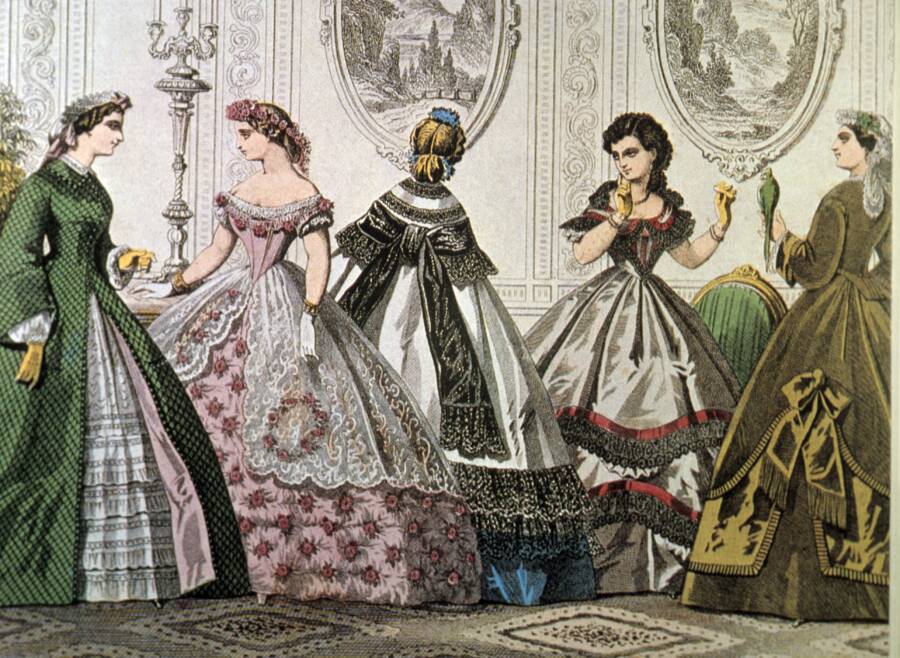
Mustang media AB/Heritage Images via Getty ImagesWomen wearing wide crinoline skirts in the 1850s.
The trend was ultimately short-lived — but very deadly. During the Victorian era, an estimated 3,000 women are estimated to have burned alive while wearing flammable crinoline skirts.
What Is Crinoline?
In the mid-19th century, Victorian women started to wear wide, hooped skirts called crinolines. An alternative to wearing multiple, stuffy layers, these skirts were structured petticoats covered with fabric. As the Massachusetts Historical Society writes, women liked crinolines because they eliminated the need for stiff undergarments and allowed the user to move more freely.
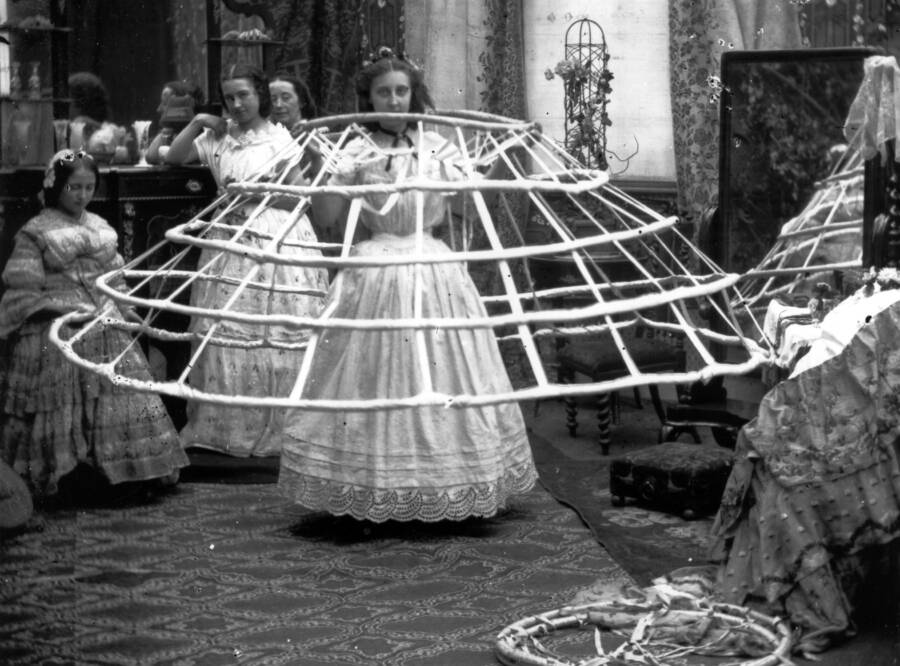
London Stereoscopic Company/Hulton Archive/Getty ImagesA woman prepares to don a crinoline skirt in an 1860s women’s dressing room in London.
However, these popular skirts were roundly mocked by men.
As the European Fashion Heritage Association notes, crinoline skirts could sometimes extend as wide as 18 feet. And cartoons of the Victorian era routinely made fun of these wide and unwieldy dresses.
“Expansive! expensive! extensive! exuberant! / Skirts, more than the city’s outskirts, protuberant! / Not only the height of the fashion has come to this, / But the breadth of the fashion is Crinoline bliss,” one cartoon from 1840 – 1880 blared, according to The Library Company of Philadelphia. Other Victorian cartoons mocked crinoline skirts as well, depicting them as crushing men at balls and keeping their wearers at mind-boggling distances from other party guests.

Public DomainA Victorian era cartoon which depicts a man being crushed by two crinoline-wearing women.
But crinoline’s worst attribute was no laughing matter. During the Victorian era, these unwieldy skirts frequently caught on fire — causing the deaths of thousands of women.
How Crinoline Killed Thousands Of Women
As Buzzfeed notes, crinoline skirts incorporated everything necessary to cause a deadly fire. They were made of flammable fabric, contained large pockets of air which could fuel a blaze, and were so wide that women often inadvertently brushed up against flames from candles or stovetops.
Scores of Victorian women infamously burned alive. One was Fanny Longfellow, the wife of poet Henry Wadsworth Longfellow, who died in July 1861 in Cambridge, Massachusetts. According to The New York Times, she had been “making seals for the entertainment of her two youngest children [when] a match or piece of lighted paper caught her dress, and she was in a moment enveloped in flames.”
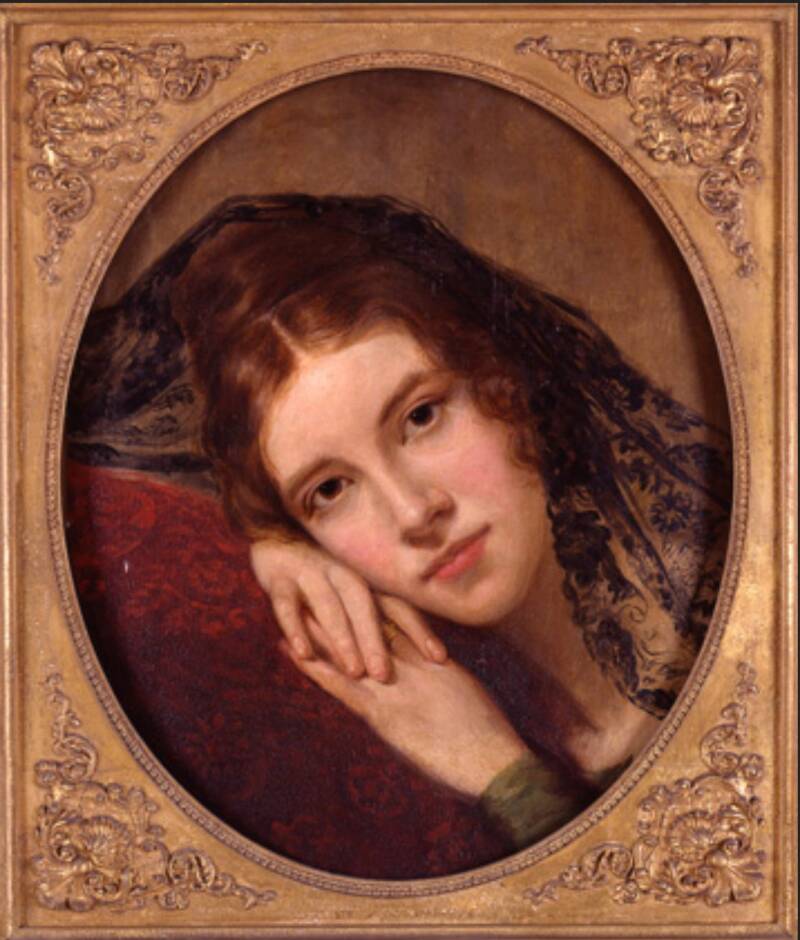
National Park ServiceFanny Longfellow, the wife of poet Henry Wadsworth Longfellow, died at the age of 43 when her skirt caught on fire.
Despite attempts to save her life, Fanny Longfellow died.
Across the Atlantic, Oscar Wilde’s half-sisters also gruesomely perished after their skirts caught on fire. The sisters attended a Halloween party on Oct. 31, 1871, in Ireland, where one of the sisters brushed against a candle and went up in flames. Her sister tried to save her life, but her crinoline also caught on fire. Both eventually perished.
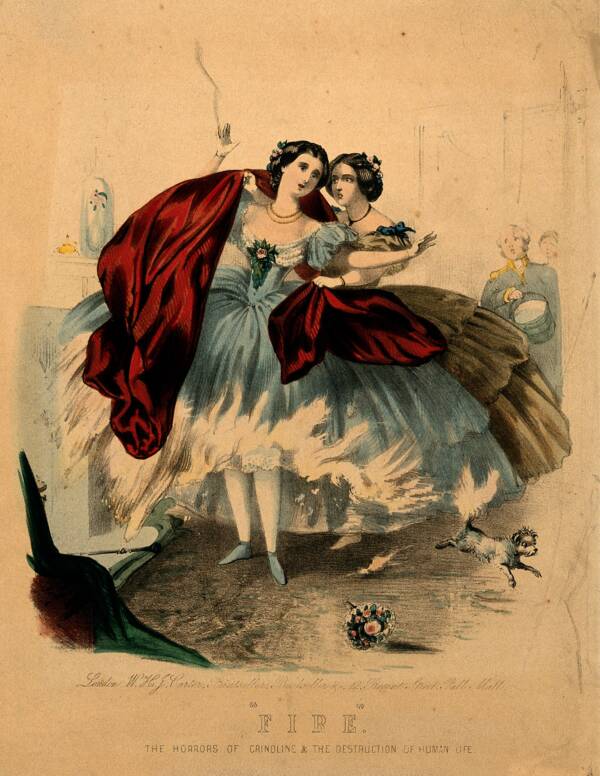
Wellcome CollectionMary and Emily Wilde, half sisters to poet Oscar Wilde, both died after their crinoline caught on fire in 1871. The caption of this image reads: “FIRE: The Horrors Of Crinoline And The Destruction Of Human Life.”
Longfellow and the Wilde sisters were hardly the only Victorian women to die in crinoline-related fires. Buzzfeed reports that more than one ballerina went up in flames after dancing too close to the stage lights, History Daily describes an 1863 incident in which a young kitchen maid died, and Mental Floss recounts that the Archduchess Mathilde of Austria died in 1867 while trying to hide a cigarette behind her back while wearing a crinoline.

The Print Collector/Heritage Images via Getty ImagesClara Webster, a young ballerina who died in 1844 after she danced too close to the gas stage lights and her dress caught on fire.
In all, most sources estimate that some 3,000 women in the Victorian era died because their crinoline dresses caught fire.
“[A]n average of three deaths per week from crinolines in conflagration, ought to startle the most thoughtless of the privileged sex,” The New York Times fretted in 1858, according to the BBC, “and to make them, at least, extraordinarily careful in their movements and behavior, if it fails… to deter them from adopting a fashion so fraught with peril.”
Yet other publications continued to meet crinoline — and crinoline-related deaths — with humor. That same year, The Tablet quipped, according to Mental Floss: “We would… suggest that every lady wearing a crinoline, should be accompanied by a footman with a pail of water.”
The End Of The Wide Skirt Trend
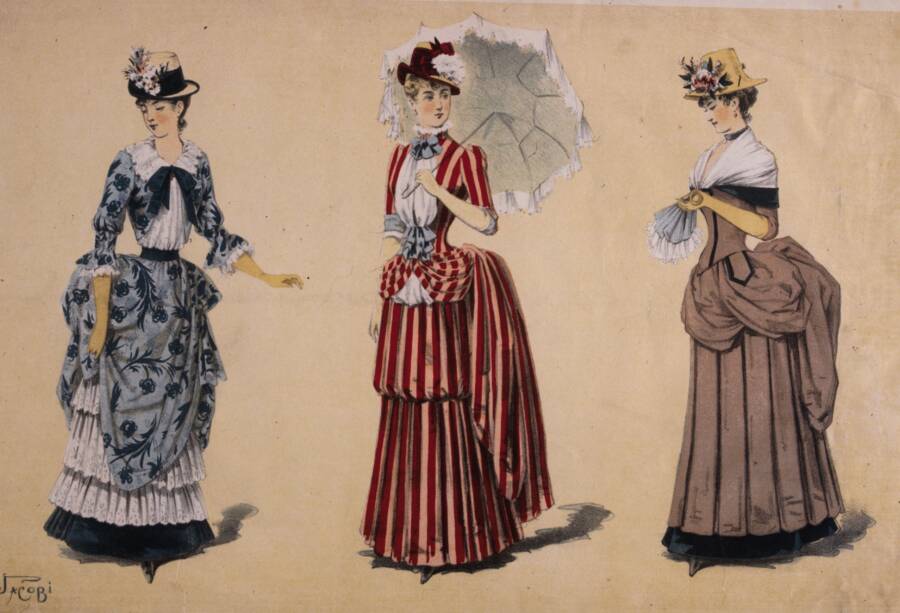
Hulton Archive/Getty ImagesWomen wearing high bustles and fitted corset lines circa 1884.
The crinoline trend may have been deadly, but it was ultimately short-lived. The Massachusetts Historical Society reports that criticism against the trend ramped up after the Civil War, with ministers taking a hard line against the flammable garment — not because it was dangerous, but because it raised the risk of seeing a woman’s undergarments or bare skin.
According to Racked, the wide hooped skirts were replaced by “bustles” in the 1870s, which were full in the back, but slim in front. Like crinoline, bustles allowed women to achieve a desirable shape. But the era of 18-foot hooped skirts was over.
At the same time, clothing manufacturers started to develop nonflammable clothing. Buzzfeed reports that the highly flammable fabric called “Flannelette” encouraged chemist William Henry Perkin to create “Dr. Perkin’s Non-Flam” in 1910. Forty years later, the United States enshrined such practices when the government passed the U.S. Flammable Fabric Act.
Today, the era of crinoline remains an odd — and disastrous — moment in Victorian history. Over a period of just a few years, thousands of women burned alive while trying to follow the latest fashion trends.
Fashion, it seems, can be fatal.
After reading about crinoline, delve into the past with these 27 facts about the Victorian era that you never learned in school. Or, peruse some of the most creative inventions from the Victorian era, like the inflatable corset.





